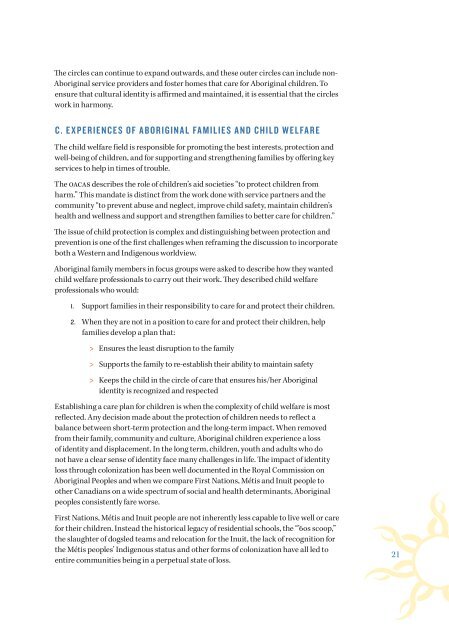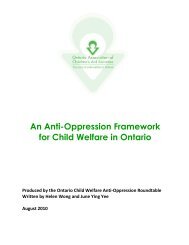English - Ontario Association of Children's Aid Societies
English - Ontario Association of Children's Aid Societies
English - Ontario Association of Children's Aid Societies
You also want an ePaper? Increase the reach of your titles
YUMPU automatically turns print PDFs into web optimized ePapers that Google loves.
The circles can continue to expand outwards, and these outer circles can include non-<br />
Aboriginal service providers and foster homes that care for Aboriginal children. To<br />
ensure that cultural identity is affirmed and maintained, it is essential that the circles<br />
work in harmony.<br />
C. EXPERIENCES OF ABORIGINAL FAMILIES AND CHILD WELFARE<br />
The child welfare field is responsible for promoting the best interests, protection and<br />
well-being <strong>of</strong> children, and for supporting and strengthening families by <strong>of</strong>fering key<br />
services to help in times <strong>of</strong> trouble.<br />
The OACAS describes the role <strong>of</strong> children’s aid societies “to protect children from<br />
harm.” This mandate is distinct from the work done with service partners and the<br />
community “to prevent abuse and neglect, improve child safety, maintain children’s<br />
health and wellness and support and strengthen families to better care for children.”<br />
The issue <strong>of</strong> child protection is complex and distinguishing between protection and<br />
prevention is one <strong>of</strong> the first challenges when reframing the discussion to incorporate<br />
both a Western and Indigenous worldview.<br />
Aboriginal family members in focus groups were asked to describe how they wanted<br />
child welfare pr<strong>of</strong>essionals to carry out their work. They described child welfare<br />
pr<strong>of</strong>essionals who would:<br />
1. Support families in their responsibility to care for and protect their children.<br />
2. When they are not in a position to care for and protect their children, help<br />
families develop a plan that:<br />
> > Ensures the least disruption to the family<br />
> > Supports the family to re-establish their ability to maintain safety<br />
> > Keeps the child in the circle <strong>of</strong> care that ensures his/her Aboriginal<br />
identity is recognized and respected<br />
Establishing a care plan for children is when the complexity <strong>of</strong> child welfare is most<br />
reflected. Any decision made about the protection <strong>of</strong> children needs to reflect a<br />
balance between short-term protection and the long-term impact. When removed<br />
from their family, community and culture, Aboriginal children experience a loss<br />
<strong>of</strong> identity and displacement. In the long term, children, youth and adults who do<br />
not have a clear sense <strong>of</strong> identity face many challenges in life. The impact <strong>of</strong> identity<br />
loss through colonization has been well documented in the Royal Commission on<br />
Aboriginal Peoples and when we compare First Nations, Métis and Inuit people to<br />
other Canadians on a wide spectrum <strong>of</strong> social and health determinants, Aboriginal<br />
peoples consistently fare worse.<br />
First Nations, Métis and Inuit people are not inherently less capable to live well or care<br />
for their children. Instead the historical legacy <strong>of</strong> residential schools, the “’60s scoop,”<br />
the slaughter <strong>of</strong> dogsled teams and relocation for the Inuit, the lack <strong>of</strong> recognition for<br />
the Métis peoples’ Indigenous status and other forms <strong>of</strong> colonization have all led to<br />
entire communities being in a perpetual state <strong>of</strong> loss.<br />
21

















